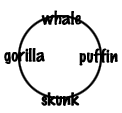1. Share a circle story.
Transformation tale: The Stonecutter by Gerald McDermott.
2. Choose a topic Ex: Four Animals
Read to find out: Where each animal lives, what it eats, what someone would notice about it, one or two facts you did not know.
3. Create a circle chart and record information about each animal.
4. Tell the circle story giving information about each animal and telling why it would want to become the next animal in the circle.
THE ORCA WHALE lives in all the world’s oceans in life-long pods of up to 150 whales. They hunt their prey at the surface of the water eating fish, birds, seals and turtles. They make high-pitched clicks that bounce off their prey. They use their big tails, tall fins and flippers to swim. Their very sharp teeth make them feared by other ocean animals.
PUFFINS can fly, swim and dig burrows. They live in the Arctic where their thick, waterproof feathers protect them from cold. They have webbed feet for swimming and stow fish in their bills which are very brightly colored. The female does not sit on her egg. When a chick is six weeks old the parents abandon it. After a week without food, the hungry bird goes to find fish for itself.
SKUNKS do not like their own smell. Active at night, they live in woods and fields. When in danger the skunk will growl, stamp its feet and spray. Wild skunks are black and white with short legs, clawed feet and long snout for eating insects, eggs and plants. Other animals and people avoid skunks.
GORILLAS live in the mountain areas of Africa in groups of six or seven. They have large arms and a bulky body, a large head and small eyes. They are covered with brown hair and have no tails. They eat juicy plants and termites, consuming about 50 pounds of food a day. Every night they make a new nest because gorillas never sleep in the same nest twice.
FOR PRACTICE: Rocks & Minerals
Galena is found in MO, KS, OK, and all over the world. It is the leading ore of silver and lead.
Formed: when water heated by magma flows through igneous & sedimentary rocks.
Composition: Dense, soft, cubed shaped crystals. Silver-gray color. State mineral of MO.
Uses: Weapons, ceramics, glassware.
Negatives: Highly toxic. Causes illness in humans.
Calcite is found: In caves all over the world.
Formed: When limestone hardens and forms stalactites and stalagmites.
Composition: Crystals come in many forms, uneven sided to small round grains.
Colors are clear, white, pink, red, green, blue. Glows in the dark.
Uses: Decoration, jewelry
Negatives: Easily scratched. Dissolves in hydrochloric acid.
Gypsum is found in sedimentary rock and in some cave formations. Rose shaped gypsum is found in clay beds of Kentucky.
Formed: When water evaporates and leaves behind solids that have been dissolved.
Composition: Sulfate mineral, white, gray, yellow, red and brown. Rose shaped crystals.
Uses: Used to make plaster and cement. Alabaster carvings.
Negatives: Breaks in one direction.
Muscovite Mica is found in Moscow
Formed: in granite and metamorphic rocks
Composition: flakes, thin sheets, clear light color that sparkles
Uses: glass, paint, wallpaper, windows, electrical insulation
Negatives: Breaks easily
Journey Story: Choose four destinations. can be ocean, mountain, desert, plains or cities, countries, states, provinces. Find: Location, List at least three sights, three important facts, one reason people leave. Tell the circle story.
Remember, this is a story containing factual information. Tell your story in a fun and enthusiastic way!

